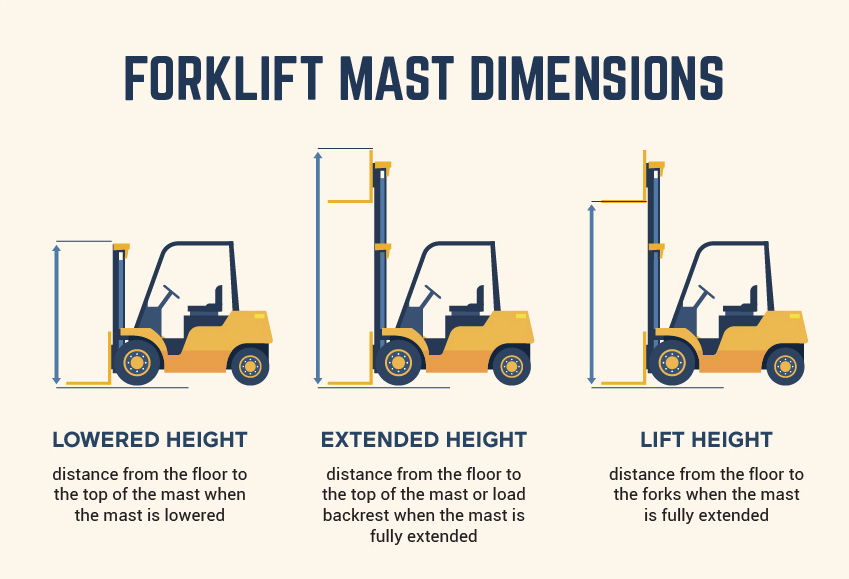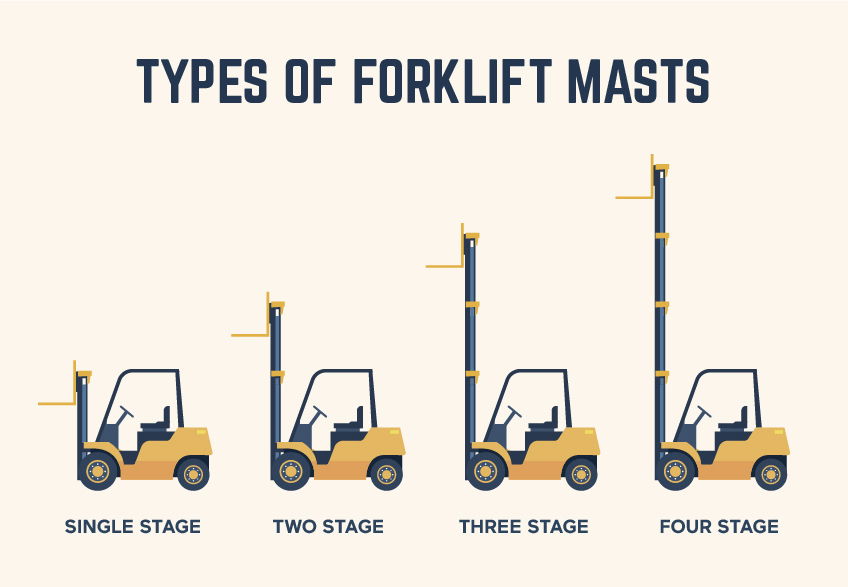Forklift Mast Types: How to Choose the Right One
What Is a Forklift Mast?
Simply put, the forklift mast, also known as the upright, is the part of the machine that does the work. It’s the mechanical structure on the front of the lift truck that allows it to raise loads to necessary heights. A forklift mast lifts by hydraulic displacement and lowers using the force of gravity. The mast has multiple sections that work together to lift. Nested rails allow the mast to extend and lower. The carriage is attached to the inner rails and chains, which are attached to both the carriage and the mast at anchors, help raise and lower it. The forks, along with other attachments, ride the carriage and are used for material handling.
Considerations When Choosing a Forklift Mast

Free Lift
One factor to consider when choosing a forklift mast is free lift, especially in a location with low overhead clearance. Free lift is how high a forklift operator can raise the forks without the mast height changing. While free lift is a huge benefit if you’re working in confined spaces, the lift mechanism can limit visibility if it is located in the center of the mast.
Lowered Height
Another factor that affects forklift mast selection is the lowered height, also known as the collapsed height. The lowered height is the distance from the floor to the top of the mast when the mast is lowered. The lowered height is especially important to consider if your forklift will be traveling through confined spaces like doorways.
Extended height
At the other end of the spectrum is the extended height of a mast. This is the distance from the floor to the top of the mast when it is fully extended.
Lift Height
Lift height isn’t the same as extended height because lift height (also known as maximum fork height, or MFH) is measured from the floor to the forks, not the top of the mast or load backrest. Typically, the recommended lift height is six inches above your highest shelf so that the forklift has room to maneuver.
Common Types of Forklift Masts

Single-Stage (Simplex) Mast
The single-stage mast, also known as a simplex mast, does not have free lift and only has one channel. The mast must extend higher to stack loads, which is why this is seen outdoors where overhead clearance isn’t a concern (i.e., no limited lifting height).
Two-Stage (Duplex) Mast
The two-stage mast, also known as a duplex mast, has free lift available and is often used for stacking and double stacking for indoor applications with limited overhead. Two-stage mast forklifts have good visibility since there aren’t as many mast sections impeding the driver’s view. There’s a hydraulic cylinder in the center of the mast to push loads upward. Loads can rise (to an extent) while the mast is stationary.
Three-Stage (Triplex) Mast
The most common and versatile forklift mast is the three-stage mast, or triplex mast. The outer stage on this mast doesn’t move. It has two sliding rails and an angled stationary rail. The triple-stage mast has free lift and can reach greater heights, making it good for warehouse applications.
Four Stage (Quad) Mast
The four-stage mast, or quad mast, has the highest reach of all. This mast has four sets of moving rails and chains and is much more complex than other masts. It’s also important to note that the four-stage mast may have restricted visibility and require special training to drive.
Conclusion
A forklift is an important tool when you’re moving and racking heavy loads. However, it’s vital to make sure you select the right forklift with the right mast and know how to prevent forklift accidents. To choose the forklift truck you need, you must know the vertical space of your facility (or if you’ll be outdoors), the height of the racks where you’ll be placing or removing loads, and the sizes and shapes of the loads to be handled. Getting the right forklift with the right mast can help make work on a job site easier.


